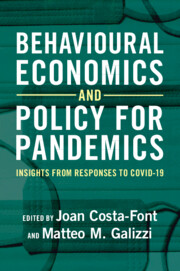Book contents
- Behavioural Economics and Policy for Pandemics
- Behavioural Economics and Policy for Pandemics
- Copyright page
- Epigraph
- Contents
- Contributors
- Preface
- Acknowledgements
- 1 Behavioural Economics and Policy for Pandemics
- Part I Evidence from Experiments and Behavioural Insights
- Part II Health Behaviours and Policies during Covid-19
- 14 The Effect of COVID-19 on Health and Health Behaviours
- 15 Mental Health and Health Behaviours among Vulnerable Populations during the COVID-19 Pandemic in the United States
- 16 Mental Health Interventions during the COVID-19 Pandemic
- 17 Wrinkles in a Pandemic?
- 18 Can Behavioural Insights Explain Ethnic Minority Vaccination Gaps?
- 19 How Can We Optimise Healthcare Delivery in the Wake of the COVID-19 Pandemic?
- 20 Biases in Vaccine Authorisation
- 21 Trust and the COVID-19 Pandemic
- 22 How Do Individuals Perceive the Risk of COVID-19 Compared to Food Poisoning and Influenza?
- Index
- References
15 - Mental Health and Health Behaviours among Vulnerable Populations during the COVID-19 Pandemic in the United States
from Part II - Health Behaviours and Policies during Covid-19
Published online by Cambridge University Press: 31 January 2025
- Behavioural Economics and Policy for Pandemics
- Behavioural Economics and Policy for Pandemics
- Copyright page
- Epigraph
- Contents
- Contributors
- Preface
- Acknowledgements
- 1 Behavioural Economics and Policy for Pandemics
- Part I Evidence from Experiments and Behavioural Insights
- Part II Health Behaviours and Policies during Covid-19
- 14 The Effect of COVID-19 on Health and Health Behaviours
- 15 Mental Health and Health Behaviours among Vulnerable Populations during the COVID-19 Pandemic in the United States
- 16 Mental Health Interventions during the COVID-19 Pandemic
- 17 Wrinkles in a Pandemic?
- 18 Can Behavioural Insights Explain Ethnic Minority Vaccination Gaps?
- 19 How Can We Optimise Healthcare Delivery in the Wake of the COVID-19 Pandemic?
- 20 Biases in Vaccine Authorisation
- 21 Trust and the COVID-19 Pandemic
- 22 How Do Individuals Perceive the Risk of COVID-19 Compared to Food Poisoning and Influenza?
- Index
- References
Summary
In this chapter, we review the evidence on the effects of the COVID-19 pandemic on health behaviours and explore observational data on mental health, anxiety medications, and time use. We focus on the most vulnerable populations: young adults, parents and children, essential workers, and minorities. First, we explore the heterogeneity in the impact of COVID-19 on mental health and then examine more closely the impact on time use, with a specific focus on health behaviours (exercise, sleeping, eating habits) and personal care. Our evidence suggests that it will be crucial to support and facilitate access to mental health services even as the number of cases and deaths associated with COVID-19 declines. It also highlights the need for intervention aimed at reaching communities that may have worse access to or face more barriers to mental care services.
- Type
- Chapter
- Information
- Behavioural Economics and Policy for PandemicsInsights from Responses to COVID-19, pp. 290 - 308Publisher: Cambridge University PressPrint publication year: 2024

